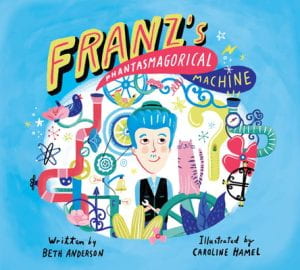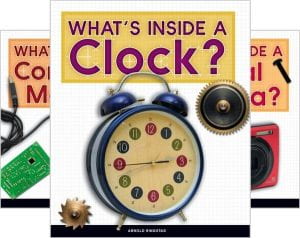 Anderson, Beth. Franz’s Phantasmagorical Machine. Kids Can Press, 2022. 978-1-525-30325-8. 32 p. $18.99. Grades K-3.
Anderson, Beth. Franz’s Phantasmagorical Machine. Kids Can Press, 2022. 978-1-525-30325-8. 32 p. $18.99. Grades K-3.
“Imagine. Discover. Create.” Throughout his childhood, these whispers call to Franz Gsellmann. The words run through his mind even as his parents rely on him to do the more practical work of helping out on the family farm. As Franz busies himself milking cows, gathering eggs, and picking apples, the whispers continue calling to him. One night, many years later, he wakes from a dream with an idea for a fantastical, magical, phantasmagorical machine. Unsure about how to make his dream machine a reality, he draws inspiration from the World’s Fair in Belgium. For the next 23 years, he visits flea markets and junkyards, filling bags and carts with odds and ends of all kinds. He hauls everything back to his workshop where he tinkers in secrecy. When he finally reveals his creation to his family and neighbors, he’s crushed when they don’t understand his vision. They want to know what the machine does, but they miss the point that sometimes, a creation doesn’t need a practical purpose. Some things can be appreciated simply for their artistic beauty, ingenuity, and creativity. Backmatter pages include a brief biography of Franz Gsellmann as well as black and white photos of him with his machine.
THOUGHTS: This title will be a thought-provoking addition to STEAM lessons as it highlights the ideas of perseverance, experimentation, creativity, and optimism. It also draws connections between science and art and shows the value of thinking outside the box. Share this with art teachers too to kickstart units about recycled art or self-taught artists.
621 Applied Physics Anne Bozievich, Southern York County SD
Picture Book

